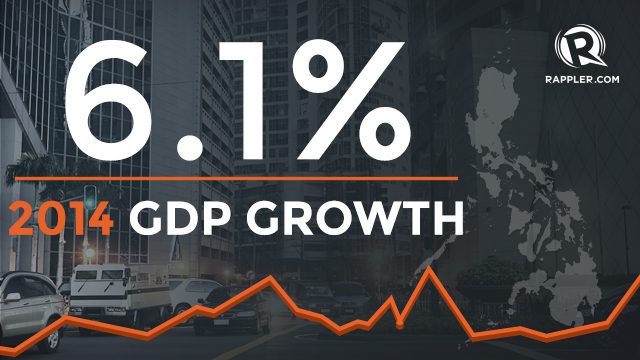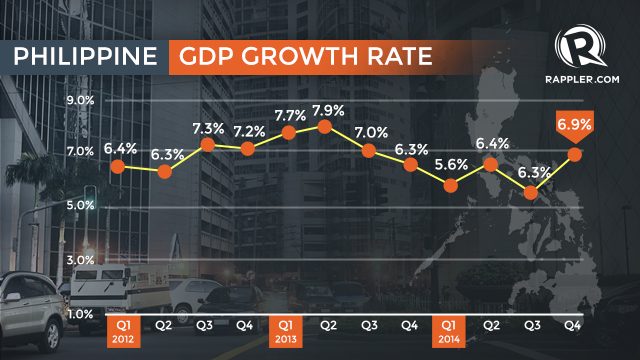SUMMARY
This is AI generated summarization, which may have errors. For context, always refer to the full article.

MANILA, Philippines (3rd UPDATE) – The Philippine economy accelerated in the fourth quarter of 2014, growing by 6.9% – higher than the previous quarter’s 5.3% and the 6.3% recorded in the same period in 2013.
National Statistician Lisa Grace Bersales revealed on Thursday, January 29, that the country’s gross domestic product (GDP) accelerated to 6.9% in the fourth quarter of last year, driven by communications, construction, manufacturing, real estate, transportation, among others. GDP is the measure of goods and services produced across the economy.
Bersales said that the latest figures bring the full-year GDP growth to 6.1% or P12.63 trillion ($286.20 trillion) – below the government target of 6.5% to 7.5%, and lower than the record-high 7.2% growth in 2013 or P11.55 trillion ($261.72 billion) at prevailing rates.
The country’s GDP slowed down to 5.3% in the third quarter of 2014, requiring at least a 7.2% growth in the fourth quarter to achieve the government target.
Analysts have forecasted that the Philippines would miss its full-year GDP target in 2014, owing largely to government underspending.
Last year, the Supreme Court ruled that certain executive actions under the government’s flagship spending scheme, the Disbursement Acceleration Program (DAP), are unconstitutional, prompting the government to discontinue fund releases for projects under the program for the rest of 2014.
“That’s the nature of development. There are surprises. The reason why some are able to do better than others is because they are able to prepare,” said National Economic and Development Authority (NEDA) director-general Arsenio M. Balisacan.
Still within ‘high growth path’

While the full-year 2014 growth decelerated, Balisacan said that the latest expansion figures are above the market expectations of 6% for the fourth quarter and 5.8% for 2014.
World Bank (WB) projected a GDP 2014 growth of 6%, lower than the WB’s earlier calculation of 6.4%.
The United Nations Economic and Social Commission for Asia and the Pacific (UN ESCAP) also slashed its 2014 growth forecast for the country to 6% from its August 2014 projection of 6.7%.
The International Monetary Fund also lowered its economic growth forecast for the Philippines to 5.8% for 2014 versus its earlier projection of 2014 GDP at 6.2%.
The ADB also slashed its 2014 growth forecast for the country to 6%, saying that despite robust private consumption, higher private investment, and net exports, weak public spending prevailed, contributing to the dismal GDP growth.
“A growth of greater than 7% is difficult to sustain in the Philippines without reforms to address supply-side constraints,” the Hongkong and Shanghai Banking Corporation Limited’s (HSBC) Global Research said in a November 2014 report.
HSBC’s forecast for 2014 full-year growth is 5.9%, while 2015 expansion is set at 6.1%.
Maybank Kim Eng Economic Research also set the same – down from its previous forecast of 6.7%.
For 2015, Maybank also lowered its GDP growth forecast to 7% from 7.5%
NEDA maintained that compared with other Asian economies, the Philippines was the third fastest in terms of growth, next to the People’s Republic of China with 7.3% and Vietnam with 7% GDP growth for the last quarter of 2014.
But on a full-year basis, the Philippines ranked second next to China with 7.4% and slightly higher than Vietnam with 6%.
With this upbeat year-end performance, the economy is anticipated to gain further traction in 2015, Balisacan said.
Growth contributors
Agriculture, industry, and services have shown positive growth in the fourth quarter of 2014.
Most notably, the agriculture industry significantly grew by 4.8% in the fourth quarter of 2014 from the 0.9% growth in the same period in 2013.
Agricultural production improved mainly due to the rebound in crops and fisheries output.
Crop production, which accounts for about 50% of total agricultural output grew by 5.7%, coming mostly from palay and corn.
Moving the harvests from the third quarter to fourth quarter for a more favorable weather condition boosted the recovery, along with the higher output attributed to the increased usage of high-yielding seed varieties.
On the supply side, agriculture and fishery are seen to continually grow due to rice and corn yield improvements, resurgence of fishery, and the moderate expansion of livestock and poultry.
The industry sector grew by 9.2% in the fourth quarter – its highest in the last 6 consecutive quarters since the third quarter of 2013.
Double-digit expansion in construction pulled up growth in the industry sector, but manufacturing remained as its biggest growth driver.
The pickup in construction pushed the industry sector’s growth rate higher as both public and private sectors sped up implementation of projects.
For private construction, major developers remained bullish due to continued strong demand for office, retail, and residential space.
The services sector also grew by 6% in the fourth quarter, the same growth for the 2014 full-year average.
The services sector remains the largest contributor to growth, with a third quarter growth in 2014 due to the recovery in public administration, communications, and transportation, plus stronger growth in real estate, renting, and business activities, which include the business process outsourcing (BPO) industry.
Meanwhile, private consumption during the fourth quarter boosted the demand side, mainly on account of higher purchases for food and non- alcoholic beverages; electricity, gas and other fuels; housing; miscellaneous goods and services; private construction; transport; and water. .
The robust private consumption also buoyed by the rising number of employed Filipinos, which grew by 2.8% to 38.8 million from 37.8 million a year ago, based on the October 2014 round of the Labor Force Survey (LFS).
The decline in the unemployment rate from 6.4% to 6.% in the same LFS round also buoyed the demand side.
Exports, on the other hand, grew by 15.5% in real terms in the fourth quarter and a full-year expansion of 12.1% relative to the previous quarter’s growth of 9.9%.
Also, exports will continue to grow despite the fragility of the global economy.
The positive developments in the global manufacturing sector were seen that exports of goods increased by 15.9% from 6.2% in the fourth quarter of 2013.
Moving forward, manufacturing will rely on buoyant exports, robust domestic demand for manufactured goods by rising household incomes, fueled partly by overseas Filipino remittances, and the rise of election-related spending.
The faster growth in exports of services to 14.1% from a 6.7% decline came mainly from the BPO sector.
Currently, the services industry employs 1.052 million Filipinos and by 2016, the BPO sector targets to achieve 1.3 million full-time employees and $25 billion in revenues, NEDA reported.
Also, the surge of private construction is expected in residential projects and office space.
Services will be bolstered by soft oil prices, vigorous domestic trade, strong financial intermediation, vibrant BPO industry, and significant international meetings like the Asia Pacific Economic Conference.
On the demand side, household consumption will likely remain buoyant, supported by better employment opportunities and remittances.
Playing catch up
Government underspending is often cited as a reason that is pulling down the country’s economic growth, with an annual performance at 1.8%, far from 2013’s 7.7%.
Maybank said the drag from the public sector was evident in government consumption, which went down 2.6% on the expenditure side while public administration services also fell 2.9% on the production side.
HSBC specifically pointed to the decline in custom imports as a symptom of infrastructure challenges, evident in Manila’s port congestion woes.
Issues over the DAP inhibited government agencies from pursuing public-private partnership (PPP) projects, but Trade and Industry Secretary Gregory Domingo previously said he is optimistic the country will be back on a “high growth path” of over 7% in 2015 through the resumption of public spending.
Thus, Balisacan cited that the government stood by its commitment to “ramp up and catch up” with its spending in the last 3 months of 2014, evident in the 9.8% increase of government final consumption expenditure in this period, leapfrogging from the 2.6% contraction in the third quarter of 2014 and from a 0.4% contraction in the last quarter of 2013.
Double-digit growths in personal services and maintenance and other operating expenses were recorded in this period as well.
Risks and prospects
Overall, Balisacan said the numbers “tell us that we are moving in the right direction.”
“There may have been some glitches along the way as we adjusted to the new systems that the government had put in place in pursuit of good governance. But clearly the economic policies and strategies we are implementing to achieve sustained and inclusive growth are bearing fruit,” Balisacan said.
Balisacan noted that the government remains vigilant against risks from the global front, with current global economic conditions still exhibiting mixed signals influenced by critical developments, like the sluggish world trade, muted commodity prices, and rising interest rates and risk spreads in many emerging market economies, versus the persistently low interest rates in major advanced economies.
While the sharp deceleration of petroleum prices beginning the second half of 2014 is benefitting oil-importing economies, it is however tempering the growth prospects of oil-exporting countries.
“The net effect to global growth, however, is positive,” Balisacan noted.
The domestic front is likely to provide vigor to the economy amid lingering and uneven external conditions, NEDA added.
Balisacan noted the private sector dynamism – while government spending underperformed 2014 – but warned that such growth mix entails risk.
“Such proportion is vulnerable to shock,” he said.
Investments plunged to 1.1% in the same period, as against to 29.9% in 2013. As such, investments will largely be fueled by the capital expenditures of big firms in the country, and, expectedly, the catching up of the government on its infrastructure program, including reconstruction in disaster-hit areas, will further drive the sector’s growth.
Balisacan said that since 2010 or the mid-year start of the Aquino administration, the country’s economic growth is becoming more competitive with our East and Southeast Asian neighbors.
“We have avoided the dreaded boom-and-bust cycle that has hounded our economy for decades,” Balisacan said.
GDP’s growth, according to Balisacan, should be contributed largely by investments and exports, instead of households consuming their income more on immediate needs.
“But the long-term (solution) is to improve institutions, quality of governance by starting with fixing the educational system, and get more people informed better,” he added.
Developing human capital would transform households from mere consumers to investors in bonds and durable equipment, he said.
And as the May 2016 elections is 16 months away, Balisacan stressed the need “to protect the gains we have so far achieved – in managing the economy, in restoring the people’s faith in the bureaucracy, in bringing about peace – which account largely for the business confidence that the country has earned.” – with reports from Lynda C. Corpuz / Rappler.com
(US$1 = P44.13)
Add a comment
How does this make you feel?
There are no comments yet. Add your comment to start the conversation.